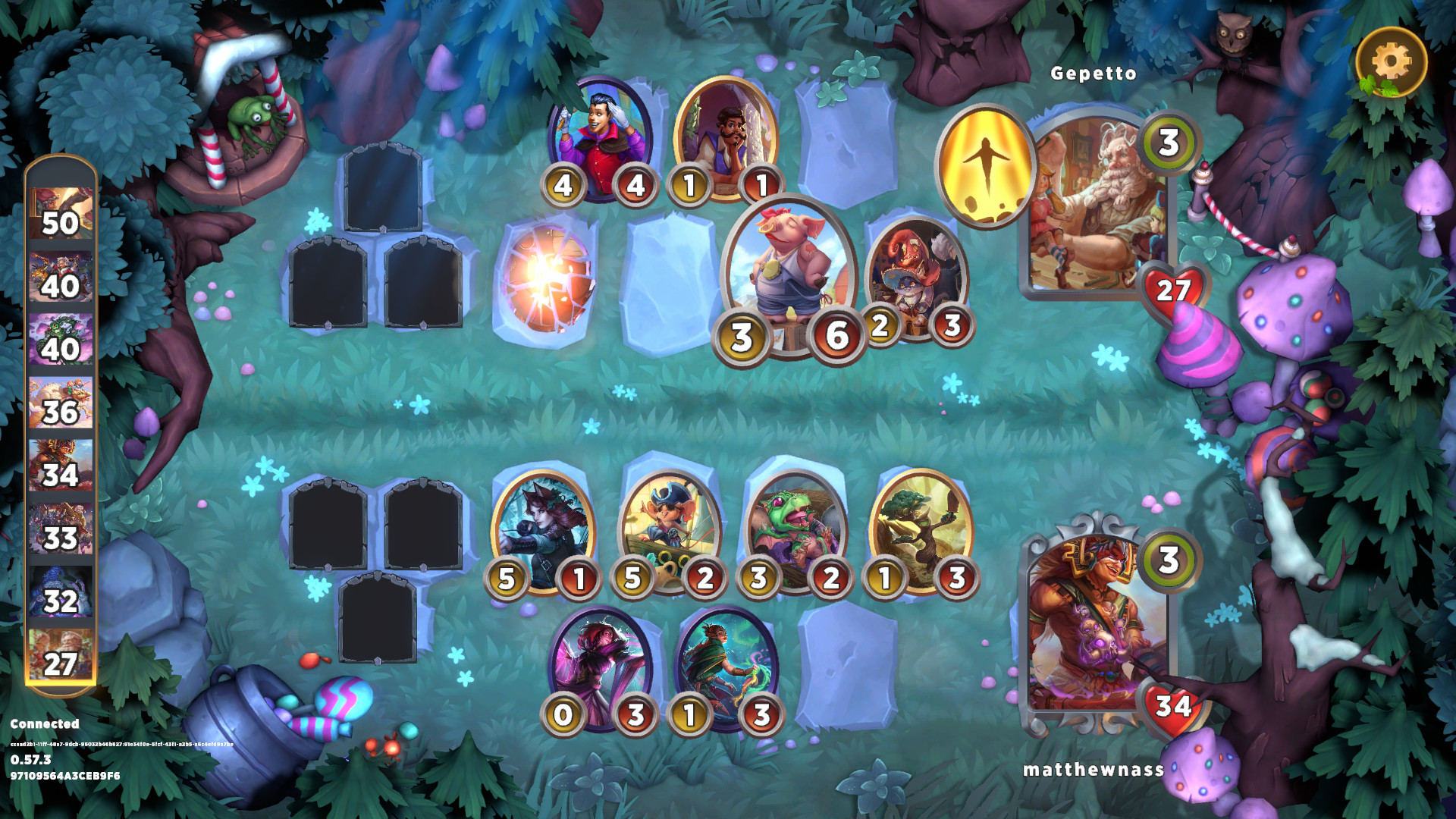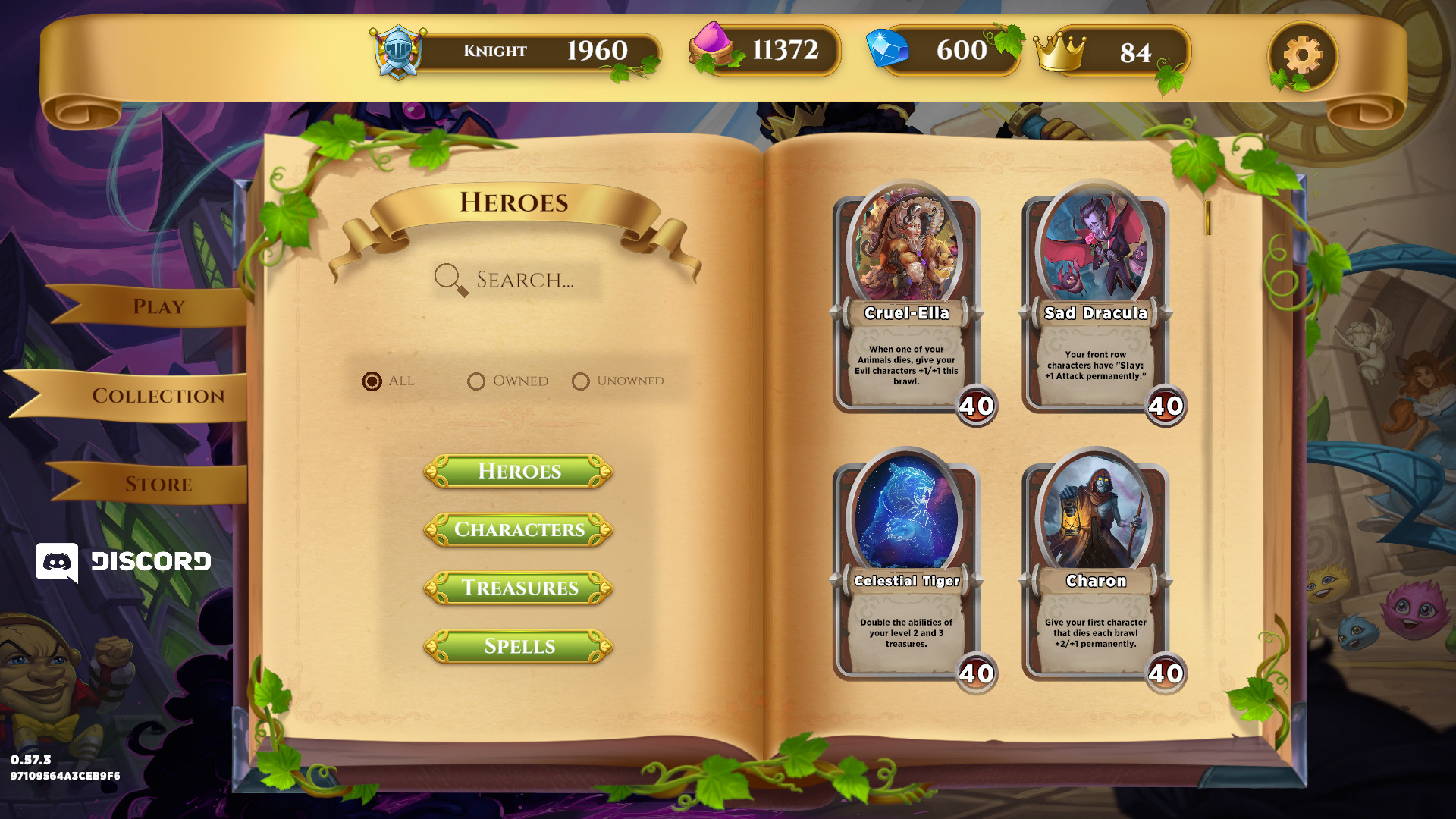Storybook Brawls tries to iterate on what Hearthstone Battlegrounds started
Throw folktale characters into a card auto battler very transparently inspired by Hearthstone Battlegrounds and you pretty much know exactly what Storybook Brawl is. It's a somewhat simpler game, with fewer interactions, and an emphasis on long-term strategies over short-term tactical combos. At the start of each round you draft a hero drawn from folk stories, fairy tales, and myths: Someone like Merlin, the Pied Piper, Gepetto, or Loki. Each hero has a unique power, some strong earlier and some later in the fight, others changing entirely how you play and strategize.
The fairy tale theme means a charming suite of art with a lot of whimsical, jovial pieces. I love the dwarf set, with their leader, the vampiric evil princess Snow Wight. There's jokes and puns both on pop culture and on the source material, all of it a good fit for a game genre that by its nature can't take itself too seriously.
It's good that the art welcomes you in, because the game mechanics absolutely do not. More than most auto battlers, success in Storybook Brawl relies on understanding what characters can be part of which combos with which heroes.
Each round you spend from an increasing pool of gold—use it or lose it—to draft one of a selection of creatures. You place your new minions on one of two lines: A front line with four places, and a back line with three. They fight the opponent's from left to right, front rank to back. Like in most auto battlers your creatures have abilities and combine with each other over time.
Those two ranks are a very slight change from other games in the genre, but they have a big impact. In the early game you can protect key pieces by putting them behind a meat shield, in the late game your combos can depend on position and order as much as on which pieces you've got on the board.
You might focus on characters which Support, giving bonuses to the characters in front of them, while giving your front rank characters all the buffs you can muster. Or you might stock up on flyers, who skip over and attack the back row, hoping to pick off your opponent's key support pieces. A lot of the coolest choices get made when you're combining pieces. Do you want to keep two vampires, each with their own powerful on-kill effect, or do you want to beef up into one big, nasty vampire and free up board space?
There are only seven places on the board, and that seven-character limit is—like in Hearthstone Battlegrounds—perhaps the big defining feature of Storybook Brawl, forcing you to be precise in what you buy and when. Each character costs gold equal to its level, and you can only hold four characters in your hand as a reserve. The economy is always tight, always limited, and you can never quite buy just what you want—nor even find it, sometimes. I lost more than a few matches because the key pieces of my hero's combo just never appeared.

Despite that, Storybook Brawl still has that edge of gambling combined with strategy. Bad luck this time, maybe next time you'll get those perfect pieces for a slick combo.
When you combine three characters of the same type they upgrade into a better version, and you also get to choose a treasure from three random choices. The treasure, like your creatures, is sorted into one of five levels (2-6) and corresponds to the level of the minions you combined.
In addition to creatures, each draft includes a spell. That might be something like a bonus to your characters for one round, or a permanent bonus, or a reward if you win the next round.

If you're keeping track here, that's an autobattler with positioning and random treasures. For all that Storybook Brawl is like Hearthstone Battlegrounds, it's also a lot like genre progenitor Auto Chess. The sheer number of random elements causes games to vary wildly from one to the next. Layering a hero character on top of artifacts, both drafted randomly from a huge pool each game, and the large pool of characters to buy, some of which combine well and some of which don't. And don't forget the spells. Storybook Brawls is a very, very crowded game.
That's perhaps its real problem. More than some derivative creature design or simple mechanics, Storybook Brawls feels unfocused. While it has the advantage of being a standalone game, it's still struggling for a unique identity among the varied mechanics of what is still an unexplored game genre, and rather than focus on one or two things as being most interesting, has instead thrown everything at the wall. They've got the rest of early access to see what sticks.
from PCGamer latest https://ift.tt/2UTPNv4
Throw folktale characters into a card auto battler very transparently inspired by Hearthstone Battlegrounds and you pretty much know exactly what Storybook Brawl is. It's a somewhat simpler game, with fewer interactions, and an emphasis on long-term strategies over short-term tactical combos. At the start of each round you draft a hero drawn from folk stories, fairy tales, and myths: Someone like Merlin, the Pied Piper, Gepetto, or Loki. Each hero has a unique power, some strong earlier and some later in the fight, others changing entirely how you play and strategize.
The fairy tale theme means a charming suite of art with a lot of whimsical, jovial pieces. I love the dwarf set, with their leader, the vampiric evil princess Snow Wight. There's jokes and puns both on pop culture and on the source material, all of it a good fit for a game genre that by its nature can't take itself too seriously.
It's good that the art welcomes you in, because the game mechanics absolutely do not. More than most auto battlers, success in Storybook Brawl relies on understanding what characters can be part of which combos with which heroes.
Each round you spend from an increasing pool of gold—use it or lose it—to draft one of a selection of creatures. You place your new minions on one of two lines: A front line with four places, and a back line with three. They fight the opponent's from left to right, front rank to back. Like in most auto battlers your creatures have abilities and combine with each other over time.
Those two ranks are a very slight change from other games in the genre, but they have a big impact. In the early game you can protect key pieces by putting them behind a meat shield, in the late game your combos can depend on position and order as much as on which pieces you've got on the board.
You might focus on characters which Support, giving bonuses to the characters in front of them, while giving your front rank characters all the buffs you can muster. Or you might stock up on flyers, who skip over and attack the back row, hoping to pick off your opponent's key support pieces. A lot of the coolest choices get made when you're combining pieces. Do you want to keep two vampires, each with their own powerful on-kill effect, or do you want to beef up into one big, nasty vampire and free up board space?
There are only seven places on the board, and that seven-character limit is—like in Hearthstone Battlegrounds—perhaps the big defining feature of Storybook Brawl, forcing you to be precise in what you buy and when. Each character costs gold equal to its level, and you can only hold four characters in your hand as a reserve. The economy is always tight, always limited, and you can never quite buy just what you want—nor even find it, sometimes. I lost more than a few matches because the key pieces of my hero's combo just never appeared.

Despite that, Storybook Brawl still has that edge of gambling combined with strategy. Bad luck this time, maybe next time you'll get those perfect pieces for a slick combo.
When you combine three characters of the same type they upgrade into a better version, and you also get to choose a treasure from three random choices. The treasure, like your creatures, is sorted into one of five levels (2-6) and corresponds to the level of the minions you combined.
In addition to creatures, each draft includes a spell. That might be something like a bonus to your characters for one round, or a permanent bonus, or a reward if you win the next round.

If you're keeping track here, that's an autobattler with positioning and random treasures. For all that Storybook Brawl is like Hearthstone Battlegrounds, it's also a lot like genre progenitor Auto Chess. The sheer number of random elements causes games to vary wildly from one to the next. Layering a hero character on top of artifacts, both drafted randomly from a huge pool each game, and the large pool of characters to buy, some of which combine well and some of which don't. And don't forget the spells. Storybook Brawls is a very, very crowded game.
That's perhaps its real problem. More than some derivative creature design or simple mechanics, Storybook Brawls feels unfocused. While it has the advantage of being a standalone game, it's still struggling for a unique identity among the varied mechanics of what is still an unexplored game genre, and rather than focus on one or two things as being most interesting, has instead thrown everything at the wall. They've got the rest of early access to see what sticks.
via IFTTT

Post a Comment